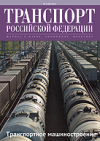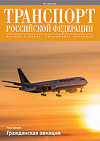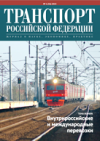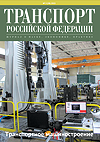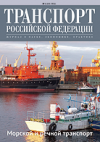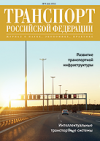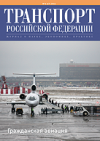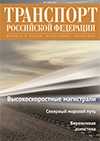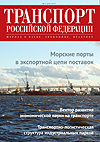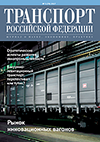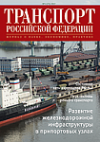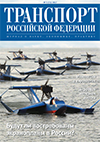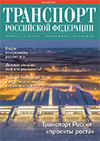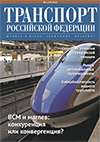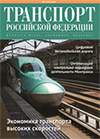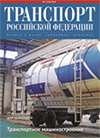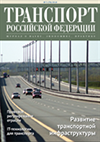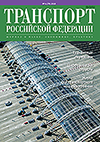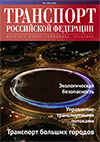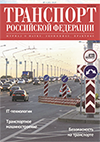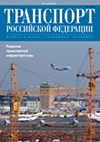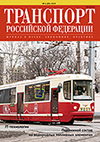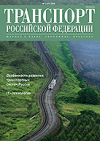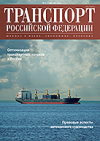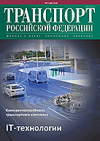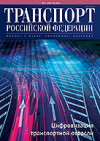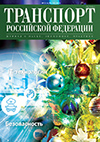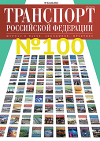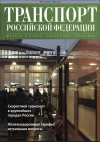ГОСУДАРСТВО И ТРАНСПОРТ
Щербанин Ю. А. «Инициатива пояса и пути»: Польша, транзит, выход на европейские пути и политика
[english]
 Скачать PDF
Скачать PDF
Iurii A. Shcherbanin, D. Sc. Econ., professor, head of transport and logistical systems analysis and forecasting laboratory, Institute of Economic Forecasting of the Russian Academy of Sciences (IEF RAS), oil and gas trading and logistics department chair, National University of Oil and Gas (Gubkin University)
The paper presents the results of analysis of development of railway communications in the context of the Belt and Road Initiative (BRI) proposed by China. It touches on certain political questions accompanying the BRI, looks at situations linked with transit development, European Union and Poland’s transport policies, and at the conditions of interaction of Sino-Russo-Belarusian-Polish railway transport at Belarusian-Polish border crossings. Forecasts for development of BRI cargo transport flows are presented.
Keywords: railways, container shipping, China, European Union, Poland, Belt and Road initiative, border crossings, Malaszewicze — Brest, transit, infrastructure.
Contacts: shcherbaninya@mail.ru
Юрий А. Щербанин, д. э. н., профессор, зав. Лабораторией анализа и прогнозирования транспортно-логистических систем Института народнохозяйственного прогнозирования РАН, зав. кафедрой нефтегазотрейдинга и логистики Российского государственного университета нефти и газа (НИУ) имени И. М. Губкина
Представлены результаты анализа развития железнодорожного сообщения в контексте «Инициативы пояса и пути» (ИПП), выдвинутой КНР и известной ранее как «Один пояс, один путь». Затрагиваются отдельные политические вопросы, сопровождающие ИПП, рассматриваются положения, связанные с развитием транзита, транспортной политики ЕС и Польши, а также условия взаимодействия китайско-российско-белорусско-польского железнодорожного транспорта на белорусско-польских погранпереходах. Представлены прогнозы развития грузового транспортного потока ИПП.
Ключевые слова:
железные дороги, контейнерные перевозки, Китай, Евросоюз, Польша, Инициатива пояса и пути, погранпереходы, Малашевичи–Брест, транзит, инфраструктура
Контакты:
shcherbaninya@mail.ru
Iurii A. Shcherbanin, Belt and Road Initiative: Poland, transit, entrance into European roads and the politics
The paper presents the results of analysis of development of railway communications in the context of the Belt and Road Initiative (BRI) proposed by China. It touches on certain political questions accompanying the BRI, looks at situations linked with transit development, European Union and Poland’s transport policies, and at the conditions of interaction of Sino-Russo-Belarusian-Polish railway transport at Belarusian-Polish border crossings. Forecasts for development of BRI cargo transport flows are presented.
Keywords: railways, container shipping, China, European Union, Poland, Belt and Road initiative, border crossings, Malaszewicze — Brest, transit, infrastructure.
Contacts: shcherbaninya@mail.ru
Семёнов С. А. Морская кибербезопасность в России
[english]
 Скачать PDF
Скачать PDF
Sergei A. Semenov, Russian Maritime Security Service head
The paper presents an overview of the normative legal acts for maritime cyber security in the Russian Federation, and considers domestic and international sources of the law. On the basis of analysis, a forecast is made for the likelihood of collisions between various normative legal acts concerning maritime cyber security, and calls attention to the need to harmonise them.
Keywords: maritime transport, cyber security, information security, cyber attack, critical information infrastructure.
Contacts: semenov@msecurity.ru
Сергей А. Семенов, начальник ФБУ «Служба морской безопасности»
Представлен обзор текущего состояния нормативного правого регулирования морской кибербезопасности в Российской Федерации, рассмотрены международные и российские источники права. На основании анализа прогнозируется вероятность коллизий между различными нормативными правовыми актами в области морской кибербезопасности, акцентируется внимание необходимости их гармонизации.
Ключевые слова:
морской транспорт, кибербезопасность, информационная безопасность, кибератака, критическая информационная инфраструктура
Контакты:
semenov@msecurity.ru
Sergei A. Semenov, Maritime cyber security in Russia
The paper presents an overview of the normative legal acts for maritime cyber security in the Russian Federation, and considers domestic and international sources of the law. On the basis of analysis, a forecast is made for the likelihood of collisions between various normative legal acts concerning maritime cyber security, and calls attention to the need to harmonise them.
Keywords: maritime transport, cyber security, information security, cyber attack, critical information infrastructure.
Contacts: semenov@msecurity.ru
Малыгин И. Г., Титова Т. С., Комашинский В. И. Железнодорожный транспорт в период четвертой индустриальной эпохи
[english]
 Скачать PDF
Скачать PDF
Igor’ G. Malygin, D. Sc. Eng., professor, director of the Solomenko Institute of Transport Problems of the Russian Academy of Sciences Tamila S. Titova, D. Sc. Eng., professor, provost for research of the Emperor Alexander I St Petersburg State Transport University (PGUPS) Vladimir I. Komashinskii, D. Sc. Eng., senior lecturer, deputy director for research of the Solomenko Institute of Transport Problems of the Russian Academy of Sciences
The paper considers the main features of the new industrial revolution (Industry 4.0) in the sphere of railway transport. The key technological platforms of the new industrial revolution in railway transport are information systems integrated with artificial intelligence (AI) technologies. Intellectualization of railway transport would facilitate optimisation of consumption of fuel and power resources, increase the degree of utilisation of carrying capacity resources of railway network, and use locomotives for transportation of passengers and cargoes in a more efficient manner. Leading role of information telecommunication technologies and AI technologies in forming national and international intelligent systems of railway and multimodal transport in the period of the fourth industrial revolution is demonstrated.
Keywords: railway transport, fourth industrial revolution, information systems, platform-orientated approach, artificial intelligence, information telecommunications system.
Contacts: kama54@rambler.ru
Игорь Г. Малыгин, д. т. н., профессор, директор Института проблем транспорта им. Н. С. Соломенко Российской академии наук (ИПТ РАН) Тамила С. Титова, д. т. н., профессор, проректор по научной работе Петербургского государственного университета путей сообщения Императора Александра I Владимир И. Комашинский, д. т. н., доцент, заместитель директора по научной работе, ИПТ РАН
В статье рассмотрены основные черты новой индустриальной революции (Industry — 4.0) в сфере железнодорожного транспорта. Ключевой технологической платформой новой индустриальной революции в железнодорожном транспорте являются информационно-управляющие системы, интегрированные с технологиями искусственного интеллекта (ИИ). Интеллектуализация железнодорожного транспорта позволит оптимизировать потребление топлива и энергетических ресурсов, повысить степень использования ресурсов пропускной способности сети железных дорог, более эффективно использовать локомотивы для перевозки пассажиров и грузов. Показана ведущая роль информационно-телекоммуникационных технологий и технологий ИИ в формировании национальной и международной интеллектуальных систем железнодорожного и мультимодального транспорта в период 4-й индустриальной революции.
Ключевые слова:
железнодорожный транспорт, четвертая индустриальная революция, информационно-управляющие системы, платформо-ориентированный подход, искусственный интеллект, информационно-телекоммуникационная система.
Контакты:
kama54@rambler.ru
Igor’ G. Malygin, Tamila S. Titova, Vladimir I. Komashinskii, Railway transport in the period of the fourth industrial age
The paper considers the main features of the new industrial revolution (Industry 4.0) in the sphere of railway transport. The key technological platforms of the new industrial revolution in railway transport are information systems integrated with artificial intelligence (AI) technologies. Intellectualization of railway transport would facilitate optimisation of consumption of fuel and power resources, increase the degree of utilisation of carrying capacity resources of railway network, and use locomotives for transportation of passengers and cargoes in a more efficient manner. Leading role of information telecommunication technologies and AI technologies in forming national and international intelligent systems of railway and multimodal transport in the period of the fourth industrial revolution is demonstrated.
Keywords: railway transport, fourth industrial revolution, information systems, platform-orientated approach, artificial intelligence, information telecommunications system.
Contacts: kama54@rambler.ru
ЭКОНОМИКА И МЕНЕДЖМЕНТ
Журавлева Н. А. Проблемы внедрения цифровых технологий на транспорте
[english]
 Скачать PDF
Скачать PDF
Natal’ia A. Zhuravleva, D. Sc. Econ., professor, transport economy department chair, Emperor Alexander I St Petersburg State Transport University (PGUPS)
Growing competition in world commodity markets is a serious challenge for transportation of global and national transport systems. This transformation reflects the requirements of the new technological paradigm, formed under the influence of active production and consumption of digital technologies. Russian transport system is losing its competitive advantages due to slow reaction to digital challenges. The objective of this study is formalisation of problems of digital retardation linked to the need for switching to new business models. Main indices of such business models are value proposition for transportation and monetisation of digital technologies being used.
Keywords: digitalisation of transport systems, business model of transportation, value of transport service.
Contacts: ipebu@mail.ru
Наталья А. Журавлева, д. э. н., профессор, зав. кафедрой «Экономика транспорта» Петербургского государственного университета путей сообщения Императора Александра I
Рост конкуренции на мировых товарных рынках является серьезным вызовом трансформации глобальных и национальных транспортных систем. Эта трансформация отражает требования нового технологического уклада, формируемого под воздействием активного производства и потребления цифровых технологий. Российская транспортная система теряет свои конкурентные преимущества в силу замедленного реагирования на цифровые вызовы. Целью данного исследования является формализация проблем цифрового отставания, связанных с необходимостью перехода к новым бизнес-моделям. Основные показатели таких бизнес-моделей — «ценностное» предложение по перевозке и монетизация используемых цифровых технологий.
Ключевые слова:
цифровизация транспортных систем, бизнес-модель перевозки, ценность транспортной услуги.
Контакты:
ipebu@mail.ru
Natal’ia A. Zhuravleva, Problems of introduction of digital technologies in transport
Growing competition in world commodity markets is a serious challenge for transportation of global and national transport systems. This transformation reflects the requirements of the new technological paradigm, formed under the influence of active production and consumption of digital technologies. Russian transport system is losing its competitive advantages due to slow reaction to digital challenges. The objective of this study is formalisation of problems of digital retardation linked to the need for switching to new business models. Main indices of such business models are value proposition for transportation and monetisation of digital technologies being used.
Keywords: digitalisation of transport systems, business model of transportation, value of transport service.
Contacts: ipebu@mail.ru
Марусин А. В., Аблязов Т. Х. Государственно-частное партнерство как механизм развития автоматизированных цифровых систем
[english]
 Скачать PDF
Скачать PDF
Aleksei V. Marusin, Cand. Sc. Eng., senior instructor of the technical operation of vehicles department, St Petersburg State University of Architecture and Civil Engineering Timur Kh. Abliazov, Cand. Sc. Econ., senior lecturer of the construction and housing utilities economy department, St Petersburg State University of Architecture and Civil Engineering
The paper argues for applicability of using the public-private partnership mechanisms on the basis of digital economy elements. Criteria and an efficiency evaluation mechanism for projects of development of automated digital systems in the transport system implemented on the basis of public-private partnerships are proposed.
Keywords: public-private partnership, transport sphere, automated digital systems, digital technologies, digital economy.
Contacts: 89312555919@mail.ru; 3234969@mail.ru
Алексей В. Марусин, к. т. н., старший преподаватель кафедры технической эксплуатации транспортных средств ФГБОУ ВО «Санкт-Петербургский государственный архитектурно-строительный университет» (СПб ГАСУ) Тимур Х. Аблязов, к. э. н., доцент кафедры экономики строительства и жилищно-коммунального хозяйства СПб ГАСУ
В статье обоснована актуальность применения механизма ГЧП на основе элементов цифровой экономики. Предложены критерии и механизм оценки эффективности проектов развития автоматизированных цифровых систем в транспортной системе, реализуемые на основе ГЧП.
Ключевые слова:
государственно-частное партнерство, транспортная сфера, автоматизированные цифровые системы, цифровые технологии, цифровая экономика.
Контакты:
89312555919@mail.ru; 3234969@mail.ru
Aleksei V. Marusin, Timur Kh. Abliazov, Public-private partnership as a mechanism for development of automated digital systems
The paper argues for applicability of using the public-private partnership mechanisms on the basis of digital economy elements. Criteria and an efficiency evaluation mechanism for projects of development of automated digital systems in the transport system implemented on the basis of public-private partnerships are proposed.
Keywords: public-private partnership, transport sphere, automated digital systems, digital technologies, digital economy.
Contacts: 89312555919@mail.ru; 3234969@mail.ru
IT-ТЕХНОЛОГИИ
Комаров В. В., Гараган С. А. Понятийный аппарат для описания систем автоматизированного вождения автотранспортных средств
[english]
 Скачать PDF
Скачать PDF
Vitaly V. Komarov, Cand. Sc. Eng., senior lecturer, first deputy director for research, Scientific and Research Institute of Motor Transport Sergei A. Garagan, D. Sc. Eng., senior research associate, Scientific and Research Institute of Motor Transport
The paper considers the levels of automation of vehicles, approaches to evaluation of efficiency of driverless transport systems, and identifies the main directions for developing driverless transport systems. Terms and definitions required for creating and developing harmonised driverless transport systems in the Russian Federation are developed. Specific features of application of vehicles of various degrees of automation are determined.
Keywords: sustainable mobility, innovative technologies, driverless transport systems, safety, terminology.
Contacts: komarov@niiat.ru; garagan@niiat.ru
Виталий В. Комаров, к. т. н., доцент, первый зам. генерального директора по научной работе ОАО «НИИАТ» Сергей А. Гараган, д. т. н., главный научный сотрудник ОАО «НИИАТ»
В статье рассмотрены уровни автоматизации транспортных средств (ТС), подходы к оценке эффективности систем автоматизированного вождения ТС, определены основные направления развития систем автоматизированного вождения ТС. Разработаны термины и определения, необходимые для создания и развития гармонизированных систем автоматизированного вождения ТС в Российской Федерации. Определены особенности использования ТС различных уровней автоматизации.
Ключевые слова:
устойчивая мобильность, инновационные технологии, системы автоматизированного вождения транспортных средств, безопасность, терминология.
Контакты:
komarov@niiat.ru; garagan@niiat.ru
Vitaly V. Komarov, Sergei A. Garagan, Conceptual framework for description of driverless transport systems
The paper considers the levels of automation of vehicles, approaches to evaluation of efficiency of driverless transport systems, and identifies the main directions for developing driverless transport systems. Terms and definitions required for creating and developing harmonised driverless transport systems in the Russian Federation are developed. Specific features of application of vehicles of various degrees of automation are determined.
Keywords: sustainable mobility, innovative technologies, driverless transport systems, safety, terminology.
Contacts: komarov@niiat.ru; garagan@niiat.ru
Ефанов Д. В., Шиленко А. С., Хорошев В. В. Концепция цифрового моделирования на железнодорожном транспорте
[english]
 Скачать PDF
Скачать PDF
Dmitrii V. Efanov, D. Sc. Eng., senior lecturer, head of monitoring and diagnostics systems division, LocoTech-Signal LLC, professor of the automation, telemechanics and communications in railway transport department, Russian University of Transport (MIIT) Aleksandr S. Shilenko, project chief engineer, Giprotranssignalsvyaz Institute — subsidiary of the Roszheldorproject JSC Valerii V. Khoroshev, PhD student, assistant of the automation, telemechanics and communications in railway transport department, Russian University of Transport (MIIT), monitoring systems process control engineer, LocoTech-Signal LLC
The paper outlines advantages of using digital modelling technologies at all life cycle stages of control devices and systems and infrastructure objects on railway transport. A conceptual model for interaction between railway transport objects using digital modelling technologies was developed. Main advantages of using the new approach at every stage of technical objects’ life cycle are outlined. Technical solutions required for full transfer of railway transport to the digital platform are proposed.
Keywords: digital transport systems, digital modelling technology, BIM technologies, BIM model, digital twin.
Contacts: TrES‑4b@yandex.ru; Shilenko_as@icloud.com; hvv91@icloud.com
Дмитрий В. Ефанов, д. т. н., доцент, руководитель направления систем мониторинга и диагностики ООО «ЛокоТех-Сигнал», профессор кафедры «Автоматика, телемеханика и связь на железнодорожном транспорте» Российского университета транспорта (РУТ (МИИТ)) Александр С. Шиленко, главный инженер проекта, Институт «Гипротранссигналсвязь» — филиал АО «Росжелдорпроект» Валерий В. Хорошев, аспирант, ассистент кафедры «Автоматика, телемеханика и связь на железнодорожном транспорте» РУТ (МИИТ), инженер-технолог систем мониторинга ООО «ЛокоТех-Сигнал»
Описаны преимущества использования цифровых технологий моделирования на всех этапах жизненного цикла устройств и систем управления и объектов инфраструктуры на железнодорожном транспорте. Разработана концептуальная модель взаимодействия объектов железнодорожного транспорта с использованием технологий цифрового моделирования. Отмечены основные преимущества использования нового подхода на каждом этапе жизненного цикла технических объектов. Предложены технические решения, необходимые для полного перехода железнодорожного транспорта на «цифровую платформу».
Ключевые слова:
цифровые транспортные системы, технология цифрового моделирования, BIM-технологии, BIM-модель, цифровой двойник.
Контакты:
TrES‑4b@yandex.ru; Shilenko_as@icloud.com; hvv91@icloud.com
Dmitrii V. Efanov, Aleksandr S. Shilenko, Valerii V. Khoroshev, Conception for digital modelling on railway transport
The paper outlines advantages of using digital modelling technologies at all life cycle stages of control devices and systems and infrastructure objects on railway transport. A conceptual model for interaction between railway transport objects using digital modelling technologies was developed. Main advantages of using the new approach at every stage of technical objects’ life cycle are outlined. Technical solutions required for full transfer of railway transport to the digital platform are proposed.
Keywords: digital transport systems, digital modelling technology, BIM technologies, BIM model, digital twin.
Contacts: TrES‑4b@yandex.ru; Shilenko_as@icloud.com; hvv91@icloud.com
Жанказиев С. В., Воробьев А. И., Морозов Д. Ю. Технические и технологические особенности автономных транспортных средств
[english]
 Скачать PDF
Скачать PDF
Sultan V. Zhankaziev, D. Sc. Eng., professor, traffic control and safety department chair, Moscow Automobile and Road Construction State Technical University (MADI) Andrei I. Vorob’ev, Cand. Sc. Eng., senior lecturer of the traffic control and safety department, Moscow Automobile and Road Construction State Technical University (MADI) Dmitrii Iu. Morozov, executive director of Intelligent Transport Systems Research Institute (OOO NII ITS)
The paper presents the information on the current situation in technological and technical areas of a projected driverless vehicle being developed by the Moscow Automobile and Road Construction State Technical University (MADI). The specific features of the process of robotization of the vehicle, of systems and instruments for collecting data, and of the main instruments of primary processing of this information are outlined. The paper also touches on the issues of prospective development of co-operative and complex intelligent transport systems on the example of technologies of automated column traffic and digital road model. The paper was financially supported by the Russian Foundation for Basic Research (RFBR) as part of research project № 18–29–16162.
Keywords: intelligent transport systems, driverless vehicle, technical aspects, digital road model, co-operative intelligent transport systems.
Contacts: sultanv@mail.ru; andrey552@yandex.ru; tdr2004@mail.ru
Султан В. Жанказиев, д. т. н., профессор, зав. кафедрой «Организация и безопасность движения» Московского автомобильно-дорожного Государственного технического университета (МАДИ) Андрей И. Воробьев, к. т. н., доцент кафедры «Организация и безопасность движения» МАДИ Дмитрий Ю. Морозов, исполнительный директор ООО «НИИ ИТС»
В статье представлена информация о текущем положении в технологической и технической областях проекта автономного транспортного средства, разрабатываемого в Московском автомобильно-дорожном государственном техническом университете (МАДИ). Раскрыты особенности процесса роботизации транспортного средства, систем и средств сбора данных, необходимых для реализации технологий автономного движения, а также основных инструментах первичной обработки этой информации. Кроме того, в статье затронуты вопросы перспективного развития кооперативных и комплексных интеллектуальных транспортных систем на примере технологий автоматизированного движения в колоннах и цифровой модели дороги. Статья создана при финансовой поддержке РФФИ в рамках научного проекта № 18–29–16162
Ключевые слова:
интеллектуальные транспортные системы, автономное транспортное средство, технические аспекты, цифровая модель дороги, кооперативные интеллектуальные транспортные системы.
Контакты:
sultanv@mail.ru; andrey552@yandex.ru; tdr2004@mail.ru
Sultan V. Zhankaziev, Andrei I. Vorob’ev, Dmitrii Iu. Morozov, Technical and technological features of driverless vehicles
The paper presents the information on the current situation in technological and technical areas of a projected driverless vehicle being developed by the Moscow Automobile and Road Construction State Technical University (MADI). The specific features of the process of robotization of the vehicle, of systems and instruments for collecting data, and of the main instruments of primary processing of this information are outlined. The paper also touches on the issues of prospective development of co-operative and complex intelligent transport systems on the example of technologies of automated column traffic and digital road model. The paper was financially supported by the Russian Foundation for Basic Research (RFBR) as part of research project № 18–29–16162.
Keywords: intelligent transport systems, driverless vehicle, technical aspects, digital road model, co-operative intelligent transport systems.
Contacts: sultanv@mail.ru; andrey552@yandex.ru; tdr2004@mail.ru
ТРАНСПОРТНАЯ ИНФРАСТРУКТУРА
Асаул М. А., Мохов А. Е. Железнодорожный переход на Сахалин: мост или туннель?
[english]
 Скачать PDF
Скачать PDF
Maksim A. Asaul, D. Sc. Econ., professor, deputy director of the transport and infrastructure department, Eurasian Economic Commission, automobile transport economy department professor, Moscow Automobile and Road Construction State Technical University (MADI) Aleksei E. Mokhov, Cand. Sc. Educ., deputy head of the natural monopolies section of the transport and infrastructure department, Eurasian Economic Commission
The paper presents a brief exploration of the options for construction of a transport crossing to the island of Sakhalin, and prospects of its integration into transport communications of the Eurasian Economic Union and other conjugated Eurasian transport projects. Two options for projected railway transport crossing to Sakhalin, tunnel and bridge, are compared, and their respective advantages are shown in reference to geopolitical situation in the passage area, to the economy and to transport conditions. An outline of the prospective ways of interaction with the Asia-Pacific countries regarding transport flows with the objective of implementation of international cross-Pacific traffic is presented.
Keywords: tunnel, bridge, transport crossing, transport traffic, railway mainline, Eurasian Economic Union, Eurasian Economic Commission, single transport space, transport services market, transit potential, transport integration, international transport corridors.
Contacts: asaul@eecommission.org
Максим А. Асаул, д. э. н., профессор, зам. директора Департамента транспорта и инфраструктуры Евразийской кономической комиссии, профессор кафедры «Экономика автомобильного транспорта Московского автомобильно-дорожного Государственного технического университета (МАДИ) Алексей Е. Мохов, к. п. н., заместитель начальника отдела естественных монополий Департамента транспорта и инфраструктуры Евразийской экономической комиссии
Предлагается краткое исследование вариантов строительства транспортного перехода на о. Сахалин, перспектив его интеграции в транспортные коммуникации Евразийского экономического союза и иных сопрягаемых евро-азиатских транспортных проектов. Проведено сравнение двух вариантов проекта транспортного железнодорожного перехода на о. Сахалин: туннель и мост и показаны преимущества одного над другим в привязке к геополитической обстановке в регионе прохождения, экономике и транспортным условиям. Представлен абрис перспективного пути взаимодействия в области транспортных потоков со странами Азиатско-Тихоокеанского региона (АТР) для реализации международного транстихоокеанского трафика.
Ключевые слова:
туннель, мост, транспортный переход, транспортный трафик, железнодорожная магистраль, Евразийский экономический союз (ЕАЭС), Евразийская экономическая комиссия (ЕЭК), единое транспортное пространство, рынок транспортных услуг, транзитный потенциал, транспортная интеграция, международные транспортные коридоры (МТК).
Контакты:
asaul@eecommission.org
Maksim A. Asaul, Aleksei E. Mokhov, Railway crossing to Sakhalin: bridge or tunnel?
The paper presents a brief exploration of the options for construction of a transport crossing to the island of Sakhalin, and prospects of its integration into transport communications of the Eurasian Economic Union and other conjugated Eurasian transport projects. Two options for projected railway transport crossing to Sakhalin, tunnel and bridge, are compared, and their respective advantages are shown in reference to geopolitical situation in the passage area, to the economy and to transport conditions. An outline of the prospective ways of interaction with the Asia-Pacific countries regarding transport flows with the objective of implementation of international cross-Pacific traffic is presented.
Keywords: tunnel, bridge, transport crossing, transport traffic, railway mainline, Eurasian Economic Union, Eurasian Economic Commission, single transport space, transport services market, transit potential, transport integration, international transport corridors.
Contacts: asaul@eecommission.org
Дудкин Е. П., Китаев С. В., Востриков О. В Опыт эксплуатации трамвайных путей в Санкт-Петербурге
[english]
 Скачать PDF
Скачать PDF
Evgenii P. Dudkin, D. Sc. Eng., professor, head of Industrial and Urban Transport research and education centre, Emperor Alexander I St Petersburg State Transport University (PGUPS) Sergei V. Kitaev, Cand. Sc. Eng., senior research associate, advisor to the director — head of technical policy service, St Petersburg State Unitary Enterprise Urban Electric Transport (SPb GUP Gorelektrotrans) Oleg V. Vostrikov, line service head, St Petersburg State Unitary Enterprise Urban Electric Transport (SPb GUP Gorelektrotrans)
Over 140 km of tram tracks of various designs on isolated and separated roadbed. The paper presents the results of analysis of operation of various designs of tram tracks in St Petersburg conditions. Recommendations on using these designs under different operational conditions were developed on the basis of these research data. Advantages and disadvantages of various designs are outlined, recommendations for their operation provided.
Keywords: tram track designs, field of application, environment, noise, vibration, lubrication.
Contacts: ed@pgups-tempus.ru
Евгений П. Дудкин, д. т. н., профессор, руководитель НОЦ «Промышленный и городской транспорт» Петербургского государственного университета путей сообщения Императора Александра I Сергей В. Китаев, к. т. н., старший научный сотрудник, советник директора — начальник службы технической политики СПб ГУП «Горэлектротранс» Олег В. Востриков, начальник службы пути СПб ГУП «Горэлектротранс»
В Петербурге уложено более 140 км различных конструкций трамвайных путей на обособленном и выделенном полотне. В статье представлены результаты анализа эксплуатации различных конструкций трамвайных путей в условиях Санкт-Петербурга. На основании данных исследований разработаны рекомендации по применению этих конструкций в различных условиях эксплуатации. Показаны достоинства и недостатки различных конструкций, даны рекомендации по их применению.
Ключевые слова:
конструкции трамвайных путей, область применения, экология,шум, вибрация, лубрикация
Контакты:
ed@pgups-tempus.ru
Evgenii P. Dudkin, Sergei V. Kitaev, Oleg V. Vostrikov, St Petersburg tram track operation experience
Over 140 km of tram tracks of various designs on isolated and separated roadbed. The paper presents the results of analysis of operation of various designs of tram tracks in St Petersburg conditions. Recommendations on using these designs under different operational conditions were developed on the basis of these research data. Advantages and disadvantages of various designs are outlined, recommendations for their operation provided.
Keywords: tram track designs, field of application, environment, noise, vibration, lubrication.
Contacts: ed@pgups-tempus.ru
ТРАНСПОРТНОЕ СТРОИТЕЛЬСТВО
Калугин А. В., Пасько Е. Г., Федоров С. А., Шевченко Д. В., Шнек В. А. Влияние конструкции крепления котла к каркасу на напряженно-деформированное состояние контейнера-цистерны
[english]
 Скачать PDF
Скачать PDF
Aleksandr V. Kalugin, bulk tanks department head, Centre for Transportation Technology Evgenii G. Pas’ko, senior research engineer, Centre for Transportation Technology Sergei A. Fedorov, Cand. Sc. Eng., director of the freight car design directorate, Centre for Transportation Technology Denis V. Shevchenko, Cand. Sc. Eng., director of the research and development directorate, Centre for Transportation Technology Vladimir A. Shnek, lead designer, Centre for Transportation Technology
The paper presents an analysis of regulatory requirements and operating conditions of tank containers in transportation of chemical cargoes on the railways of the Russian Federation. It shows that the choice of design solution has to be made at the initial stage of designing the tank containers. Mathematical simulation methods allow solving the task of finding the optimal design solution in the shortest amount of time for building reliable and economically efficient rolling stock.
Keywords: tank container, maximum laden weight, transportation, container design, carrying frame, boiler, underframe, pipe fitting, strength condition, application of load, area of stress concentration, stress-strain state.
Contacts: info@tt-center.ru
Александр В. Калугин, руководитель отдела «Наливные цистерны» ООО «Всесоюзный научно-исследовательский центр транспортных технологий» (ВНИЦТТ) Евгений Г. Пасько, старший инженер-исследователь ВНИЦТТ Сергей А. Федоров, к. т. н., директор дирекции проектирования грузовых вагонов ВНИЦТТ Денис В. Шевченко, к. т. н., директор научно-исследовательской дирекции ВНИЦТТ Владимир А. Шнек, ведущий инженер-конструктор ВНИЦТТ
В статье представлен анализ нормативных требований и условий эксплуатации контейнеров-цистерн при перевозке химических грузов по железным дорогам Российской Федерации. Доказано, что при проектировании контейнеров-цистерн выбор конструктивного решения должен быть сделан на начальном этапе. При помощи методов математического моделирования можно решить задачу — в минимальные сроки найти оптимальное конструктивное решение, которое позволит строить надежный и экономически эффективный подвижной состав.
Ключевые слова:
контейнер-цистерна, разрешенная масса, перевозка, конструкция контейнера, несущий каркас, котел, рама, фитинг, условие прочности, нагрузка, область концентрации напряжений, напряженно-деформированное состояние.
Контакты:
info@tt-center.ru
Aleksandr V. Kalugin, Evgenii G. Pas’ko, Sergei A. Fedorov, Denis V. Shevchenko, Influence of the design of boiler brace to frame on stress-strain state of tank container
The paper presents an analysis of regulatory requirements and operating conditions of tank containers in transportation of chemical cargoes on the railways of the Russian Federation. It shows that the choice of design solution has to be made at the initial stage of designing the tank containers. Mathematical simulation methods allow solving the task of finding the optimal design solution in the shortest amount of time for building reliable and economically efficient rolling stock.
Keywords: tank container, maximum laden weight, transportation, container design, carrying frame, boiler, underframe, pipe fitting, strength condition, application of load, area of stress concentration, stress-strain state.
Contacts: info@tt-center.ru
Бороненко Ю. П., Рахимов Р. В., Житков Ю. Б., Поволоцкая Г. А. Выбор схемы установки датчиков на железнодорожном пути для выявления дефектов колес
[english]
 Скачать PDF
Скачать PDF
Iurii P. Boronenko, D. Sc. Eng., professor, wagons and rolling stock department chair, Emperor Alexander I St Petersburg State Transport University (PGUPS) Rustam V. Rakhimov, Cand. Sc. Eng., doctoral candidate, Emperor Alexander I St Petersburg State Transport University (PGUPS) Iurii B. Zhitkov, Cand. Sc. Eng., head of rolling stock dynamics department, Wagons Innovative Centre SC (AO NVTs Vagony) Galina A. Povolotskaia, engineer of rolling stock dynamics department, Wagons Innovative Centre SC (AO NVTs Vagony)
The objective of the paper is selection of a scheme of measuring railway track for evaluation of vertical effect of rolling stock on railway track. With the purpose of solving the problem, a mathematical model of examination of a wheel during its movement through the measuring section was developed in the MathCad software package, various schemes for installation of sensors on the measuring section were considered, and the dimensions of inspected zones of the wheel as a factor of its diameter were established after passing through various schemes of the measuring section. As a result, the optimum option for the diagram of the measuring section of the railway track was selected, allowing for identifying wheel defects across the full surface of the wheels of various diameters.
Keywords: diagram of the measuring section of the track, track impact, rolling stock, measuring zone, wheel inspection, mathematical model.
Contacts: boron49@yandex.ru; rakhimovrv@yandex.ru
Юрий П. Бороненко, д. т. н., профессор, заведующий кафедрой «Вагоны и вагонное хозяйство» Петербургского государственного университета путей сообщения Императора Александра I (ПГУПС) Рустам В. Рахимов, к. т. н., докторант ПГУПС Юрий Б. Житков, к. т. н., начальник отдела динамики подвижного состава АО «НВЦ «Вагоны» Галина А. Поволоцкая, инженер отдела динамики подвижного состава АО «НВЦ «Вагоны»
Цель работы — выбор схемы измерительного железнодорожного пути для определения вертикального воздействия подвижного состава на железнодорожный путь. Для решения задачи в программном комплексе MathCad разработана математическая модель обследования колеса при его движении по измерительному участку, рассмотрены различные схемы установки датчиков на измерительном участке, определены величины обследованных зон колеса в зависимости от его диаметра после прохождения различных схем измерительного участка. В результате выбран оптимальный вариант схемы измерительного участка железнодорожного пути, который позволит выявлять дефекты колес по всей поверхности при их различном диаметре.
Ключевые слова:
схема измерительного участка пути, воздействие на путь, подвижной состав, измерительная зона, обследование колеса, математическая модель.
Контакты:
boron49@yandex.ru; rakhimovrv@yandex.ru
Iurii P. Boronenko, Rustam V. Rakhimov, Iurii B. Zhitkov, Galina A. Povolotskaia, Selection of sensor installation diagram on railway track for identification of wheel defects
The objective of the paper is selection of a scheme of measuring railway track for evaluation of vertical effect of rolling stock on railway track. With the purpose of solving the problem, a mathematical model of examination of a wheel during its movement through the measuring section was developed in the MathCad software package, various schemes for installation of sensors on the measuring section were considered, and the dimensions of inspected zones of the wheel as a factor of its diameter were established after passing through various schemes of the measuring section. As a result, the optimum option for the diagram of the measuring section of the railway track was selected, allowing for identifying wheel defects across the full surface of the wheels of various diameters.
Keywords: diagram of the measuring section of the track, track impact, rolling stock, measuring zone, wheel inspection, mathematical model.
Contacts: boron49@yandex.ru; rakhimovrv@yandex.ru











































